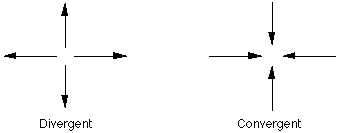

A Square is somebody who feels most comfortable with a stable environment and clear directions on what to do. She is conservative and likes things that are regular and orderly. If given a task she will work on it until it is finished, even if it is repetitious, cumbersome and lonely.
A Rectangle also likes structure and regularity. But she will more establish it with organization, meetings, committees and so forth. This will have to be done the proper way, taking all rules and regulations into consideration. If given a task she will start organizing it to be sure it can be done the most systematic way.
A Triangle is goal oriented. She enjoys planning something out and then doing it. She gets motivated by the accomplishment. She will tend to look at big long-term issues, but might forget the details. When given a task she will set a goal and work on a plan for it.
A Circle is social and communicative. No hard edges. She handles things by talking about them and smoothing things out with everybody. Communication is the first priority, and making sure there is harmony. When given a task she will talk about it.
A Squiggle is off-the-wall and creative. She feels best doing new and different things most of the time and gets bored with regularity. When given a task she will come up with bright ideas about it.

The Square, Rectangle and Triangle are all convergent. They are working towards something specific and finite, and they do it in a logical and systematic way. But they might be lacking in personal creativity.
The Circle and Squiggle are divergent. They are creative, extroverted, and intuitive. They will reach out around them into new areas and to other people. But they aren't particularly systematic or dependable.
This kind of categorization is very useful for evaluating people for job positions, for example, or for finding out how well people will work together. If you really need something specific done, the Square is the most likely to do it exactly as specified. Squares will work great in the accounting department. If things need to be organized amongst a group of people, then the Rectangle is most likely to make that happen. A Triangle might be a good executive, setting goals and making sure they are met. For any kind of personal relations the Circle will be good. A Circle will be a good personnel person or a receptionist or customer service. If anything new is needed a Squiggle is the person for the job. Advertising, problem solving etc.
The different categories of people might often get in conflicts with each other if they don't realize that they each work differently. The convergent people might be really frustrated that the divergent ones don't seem to be able to get done what they are supposed to, but will do all kinds of other things and not care about deadlines. The divergent people might find the convergent ones cold and narrow minded, not taking human factors and new possibilities into consideration.
Now, for processing purposes these categorizations are also useful. It can tell us a person's preferred method of working with something.
A Square will need fairly specific instructions. She will not be happy just floating around, not knowing where this is going. A Square will feel good about being presented with a technique and carrying it through until it is done. It doesn't matter much if it is repetitious, regularity is a source of comfort. For a Square it is a good idea to have more of a formal routine, certain rituals that are repeated.
A Rectangle needs to see how things are organized. A systematic overview of the processing we will do would be a good idea. And the Rectangle will probably also enjoy understanding the principles of what we are doing. She will feel comfortable knowing and noticing that systematic techniques are being used and that they have names and so forth.
A Triangle needs to see a goal and needs to see some accomplishments. She might appreciate having a chart of steps we are following. She will take great pleasure in checking off each one that gets done. It should always be clear what the underlying intention is with what we do. If the direction is agreed upon, the Triangle can be quite flexible in how we get there.
A Circle doesn't need a plan or a system and is probably turned off by it. She needs to talk about whatever is at hand. You need to be flexible in tracking with her and dealing with whatever is going on. Getting to an overall harmonious situation is more important than getting techniques done right.
A Squiggle must be presented with new and different things. Unexpected angles is what will motivate her. It is perfectly fine if no kind of technique is recognized and every session is different. Be flexible enough to jump around a bit and avoid preconceived ideas about where we will end up.
People are different. If you aren't able to adjust to different personality types you will probably mainly attract the ones that are similar to yourself, and others just won't appreciate what you do. If you do recognize the different types of people and if you approximate their reality then there is no limit to who you can deal with successfully.
If it isn't apparent already, there is no value judgment connected with which category people fall in. None of them are better than the other ones. Each one is a somewhat fragmented package. It has qualities that are good for certain purposes and it has qualities that aren't so good for other purposes.
The best way of testing these is probably to ask the person to pick the figure she likes the most and then the figure she likes the second most. That gives a more composite picture. Then the qualities might blend or balance each other somewhat.